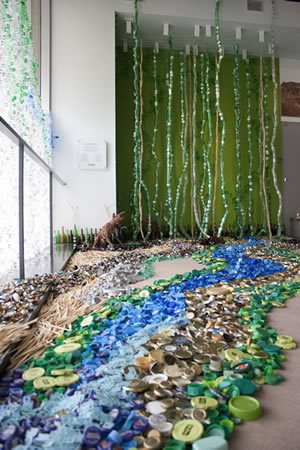Can washboards, bottle tops, and trashcans be transmogrified into objects d’art? Three disparate shows at the Gregg Museum at North Carolina State University insist that indeed they can.
Walk into the Gregg’s entry room and you will face a window agleam with bright transparent rondels: over 3,000 clear and green plastic bottles glued to the window. To the right, strings of green plastic fall from the ceiling into streams of blue and bronze bottle caps running across the floor Here and around the room Bryant Holsenbeck has overseen the creation of a brilliant series of abstractions formed of broken bottles, caps, straw, toys, and other castoffs, all part of a show labeled “Streaming: New Art from Old Bottles.” But Holsenbeck, we are reminded, is an environmental artist. She and a cadre of students scoured the NCSU campus for one day, collecting great mounds of the items we use once and then throw away, to fester in our world, perhaps forever. Her installations are beautiful, but, she insists, are meant to call attention to the enormous damage these throwaways do to our rivers and oceans. After all, the mountains of junk were gathered in one day on one campus.
On one side of the entry room, in the Gregg’s largest gallery, you will find “Art Without Artists,” a huge collection of single found objects, including “found” photographs, each seen as “artful” in its own right. It has enormous range and variety – from dress dummies to washboards, from street signs to insect collections, from heavy fire masks to a life mask of William Blake, from mug shots of criminals to a much used bulletin board.
The show, co-curated by Gregg director Roger Manley and St. Louis graphic designer John Foster, does of course raise questions about the significance and nature of “art” as it is intended to. But however we define art, the simple act of taking objects completely out of context and placing them on gallery walls and in vitrines forces us to examine them anew, and, often enough, turn them into something interesting, unfamiliar, and even mysterious. There was something otherworldly in an old firefighter mask, something quite weird about the eyeless metal mask with a Roman haircut once used by ophthalmology students when it was supplied with pig’s eyes. Some of the objects would not be out of place in a show of primitive art, of the sort that fascinated artists from the 19th century on: there, if it were not for the labels, I might pass without comment “Grinding Mill Post,” or a wall of bootjacks once used to pull off cowboy boots. I might – I hate to confess – simply admire their non-western form.
On the other side of the entry, in the Gregg’s smallest gallery, “SPIRIT – FIRE – SHAKE!” has both carved and found materials in work by three African-American artists – Renee Stout, Kevin Sampson, and Odinga Tyehimba (for a short bio of whom, click here). The found objects are neither singled out nor set in abstract installations.
Dominating the room is Tyehimba’s fierce installation of eight figures and altars, several tied to branches or crosses or with hangman’s nooses draped over them. Much of it aimed at racial oppression, the installation “Rebel Shrine” has been over 11 years in the making by the Durham artist, whose work reflects Christian and African belief systems. Front and center is a black death’s head, its carved eyeless skull jauntily top-hatted, its skeletal arms covered with nooses. Near it another black figure, this one tied to a cross, stands in a metal trash bin surrounded by white stakes suggesting ivory tusks. A knife he aims at his throat may hint that some of his problems are self-inflicted. A smaller black figure within the shrine is clearly and horribly crucified.
Renee Stout, who has received a number of important awards, created a fictitious herbalist, conjurer and fortuneteller, Fatima Mayfield, as an alter ego and has a good deal of serious fun with her. In signage and bottles, Fatima provides hope – herbs for protection, love, luck in gambling. More intriguing is her “House of Chance and Mischief,” built on an arcade game and supporting a bust of Legba, deity of chance and the West African guardian of the crossroads. The title of the assemblage is the name “Stout,” assigned to Fatima’s home. According to her notes, there is a knothole in the side of the arcade box where passersby can push wishful notes.
Kevin Sampson, a much decorated former policeman, and the son of a civil rights leader, has been creating objects, sardonic and otherwise, for years, employing very mixed media and materials. He began with a series of memorial altars after he suffered a number of deaths including his wife, one son, and others close to him. Later he branched out to broader themes. He attacks Wall Street as a murderer of the middle class. Tiny skulls litter the piece. Toy tracks are reminders, he says, of the robber barons who made huge fortunes in the 19th century. A large “altar” titled “The Treaty of Tordesillas,” Sampson notes, “is about the colonization of South America and the replacement of the indigenous gods with Christianity.” The treaty is a reminder of the arrogance with which Pope Alexander VI took it upon himself to divide newly-discovered South America between Spain and Portugal in 1493, one year after Columbus’ voyage. The piece, he says, deals not only with Western ignorance, but contains “a story of how the old gods are still watching over the people.”
The Gregg does, of course, note that it was Marcel Duchamp who first insisted on entering found objects into art shows. A bottle drier and urinal appear at the opening of “Art Without Artists.”
The three imaginatively conceived shows come down December 16. For details, see the sidebar.












